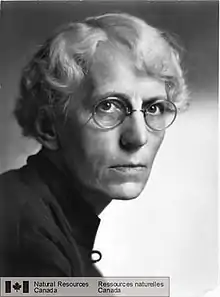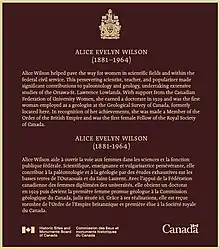Alice Wilson
Alice Evelyn Wilson, MBE, FRSC, FRCGS (August 26, 1881 – April 15, 1964) was Canada's first female geologist.[1] Her scientific studies of the rocks and fossils of the Ottawa region between 1913 and 1963 remain a respected source of knowledge.[2]
Alice Wilson | |
|---|---|
 | |
| Born | August 26, 1881 Cobourg, Ontario, Canada |
| Died | April 15, 1964 (aged 82) Ottawa, Ontario, Canada |
| Alma mater | University of Chicago and Victoria University, Toronto |
| Known for | First female geologist in Canada |
| Scientific career | |
| Fields | Geologist |
| Institutions | Geological Survey of Canada |
Life and career
Wilson was born in Cobourg, Ontario in 1881 to father professor John Wilson[3]. From childhood she was exposed to nature often through canoeing and camping trips with her father and 2 brothers. These trips sparked her interest in fossils and the study of geology. Her family encouraged scholarly thought and the pursuit of scientific knowledge.[2] In 1901 Wilson began studying modern language and history at the Victoria College in Toronto. She did not finish her last year of studies due to ill health. But she was hired by the Mineralogy Division of the University of Toronto Museum, thus beginning her career in geology.[2] She later completed her degree and, in 1907, she took an assistant job at the Victoria Memorial Museum, and then became eligible and took a temporary clerk position at the Geological Survey of Canada (GSC), which was headquartered at the Victoria Memorial Museum in Ottawa. She was then asked to translate some materials from German because of her past modern language degree, and did so well that she was given the opportunity to take a leave of absence in 1910 to finish her degree, and was given a permanent position at the GSC, which no other woman did fieldwork with until 1970.
Despite being eligible to undertake a PhD in 1915, Wilson was repeatedly denied paid time off from the GSC, even though the GSC was granting paid absences at the time. For seven years Wilson persisted, and finally was awarded a scholarship by the Canadian Federation of University Women (CFUW) in 1926. Even then, the GSC contended Wilson's leave. After a lobbying effort from the CRUW, Wilson was granted leave, and graduated in 1929 from the University of Chicago with a doctorate in geology.[4]
In 1916, during the First World War Wilson's place of work, the Victoria Memorial Museum, was shut down and reoccupied as a war-time parliament. During this time, Wilson funded her projects with her own money studying comparative anatomy and marine biology in Long Island, New York. Later, Wilson took part in the war-time effort on the homefront, joining the Canadian equivalent of the Women's Land Army. At war's end in 1920, Wilson was back at the Victoria Memorial Museum, now as an Assistant Paleontologist.[5]
While working at the GSC, they did not allow women work together with men during fieldwork. So Wilson created her own niche and did fieldwork at local sites in the Ottawa area, going on to eventually map over 14,000 km of the Ottawa St Lawrence Lowlands entirely on her own. For fifty years she studied the area on foot, by bicycle and eventually by car.[1] The GSC published the results of her fieldwork in 1946 and her Geology of the St. Lawrence Lowland, Ontario and Quebec was the first major geological publication about the area. In addition to a comprehensive discussion of its geology, Wilson covered the area's economic resources, including building stone, sand, gravel and drinking water. Wilson's research into the stratigraphy and invertebrate palaeontology of the Palaeozoic strata of eastern Canada was significant, though her contributions to the field did not gain recognition until after her retirement.[6] In Ontario, her focus was on invertebrate fossils during the Ordovician period, specifically sediments and fossils in the Ottawa Valley. In the Rocky Mountains and the Arctic, Wilson studied Ordovician fauna.[7] During the Great Depression, however, Wilson had to switch her focus from Ordovician to Devonian rocks, to meet the growing demand of petroleum in Western Canada. One of her tasks was to identify and categorize all Paleozoic invertebrates for examination. As a result, Wilson ordered the National Type Collection of fossils—an internationally recognized reference collection.[8]
From 1948 until 1958 Wilson was a lecturer in Paleontology at Carleton College (later Carleton University). Carleton recognized Wilson both as a geologist and as an inspiring teacher with an honorary degree in 1960.[2] Wilson also worked to bring geology to a broader public. She wrote a children's book, The Earth Beneath our Feet, aimed at encouraging broader knowledge and interest in the science she was so passionate about.[9]
Wilson became a respected member of the GSC and mentor to many young geologists. However, she was not referred to as Dr. by her colleagues until 1945-- 16 years after she obtained her PhD.[10] She retired two years later in 1947 at the age of 65, as was required by law. However, she kept her office at the GSC and continued her work until her death in 1964.[11]
Awards and professional recognition

Wilson was the first woman geologist hired by the Geological Survey of Canada (1909), one of the first two women elected as Fellows of The Royal Canadian Geographical Society (1930);[12] the first Canadian woman to be admitted to the Geological Society of America (1936) and the first female Fellow of the Royal Society of Canada (1938).[13]
In 1935, when the government of R.B. Bennett was looking to honour a woman in the federal civil service, Wilson was chosen to become a Member of the Order of the British Empire.
In 1991 the Royal Society of Canada established the Alice Wilson Awards for emerging women scholars.[14] Wilson was inducted into the Canadian Science and Engineering Hall of Fame in 2005.[14]
As of 18 October 2018, the Government of Canada dedicated a plaque to Wilson, recognizing her as "person of national historic significance at the Canadian Museum of Nature." [15]
Selected publications
- 1946: Geology of the Ottawa-St. Lawrence lowland, Ontario and Quebec. E. Cloutier, Ottawa
- 1948: Miscellaneous classes of fossils: Ottawa formation, Ottawa-St. Lawrence Valley. E. Cloutier, Ottawa
- 1951: Gastropoda and Conularida of the Ottawa formation of the Ottawa-St. Lawrence lowland. E. Cloutier, Ottawa
See also
References
- "Alice Evelyn Wilson is the first female geologist in Canada". Immigration to Canada. 2019-09-30., private website
- "First female geologist in Canada and first woman to become a member of the Royal Society of Canada". Library and Archives Canada. 2016-11-01.
- "Alice Wilson | The Canadian Encyclopedia". www.thecanadianencyclopedia.ca. Retrieved 2021-02-08.
- Cobourg; K9a 5p4, On. "Alice Wilson (1881-1964) Geologist". images.ourontario.ca. Retrieved 2021-02-08.
- "Alice Wilson; First Woman Geologist". login.ezproxy.lib.ucalgary.ca. Retrieved 2021-02-08.
- Sarjeant, William (1993-01-01). "Alice Wilson, First Woman Geologist With The Geological Survey of Canada". Earth Sciences History. 12 (2): 122–128. doi:10.17704/eshi.12.2.m712pvg107v21804. ISSN 0736-623X.
- "Alice Wilson | The Canadian Encyclopedia". www.thecanadianencyclopedia.ca. Retrieved 2021-02-08.
- Sarjeant, William A. S. (1993). "ALICE WILSON, FIRST WOMAN GEOLOGIST WITH THE GEOLOGICAL SURVEY OF CANADA". Earth Sciences History. 12 (2): 122–128. ISSN 0736-623X.
- "Alice Wilson; First woman geologist in Canada, expert in palaeozoic formations". Science.ca. 2016-11-01.
- "science.ca : Alice Wilson". www.science.ca. Retrieved 2021-02-08.
- "Alice's Adventures in Geology". Ingenium Innovation Storybook. 2016-11-02.
- Fellows Register, The Royal Canadian Geographical Society
- "Meet Alice Wilson, the Canadian geologist who did the work of five people". massivesci.com. Retrieved 2020-04-23.
- "Alice Wilson Awards". The Royal Society of Canada. Archived from the original on 2018-07-24.
- Canada, Parks (2018-10-18). "Government of Canada Recognizes National Historic Significance of Geologist Alice Evelyn Wilson". gcnws. Retrieved 2021-02-08.
External links
| Wikisource has original works written by or about: Alice Wilson |
- Alice Wilson at The Canadian Encyclopedia
- Royal Society of Canada's biography
- "Trailblazer". Natural Resources Canada. Archived from the original on 12 December 2006. Retrieved 29 January 2016.
- Works by or about Alice Wilson at Internet Archive
- The History of the Geological Survey of Canada in 175 Objects
- L’histoire de la Commission géologique du Canada illustrée par 175 objets